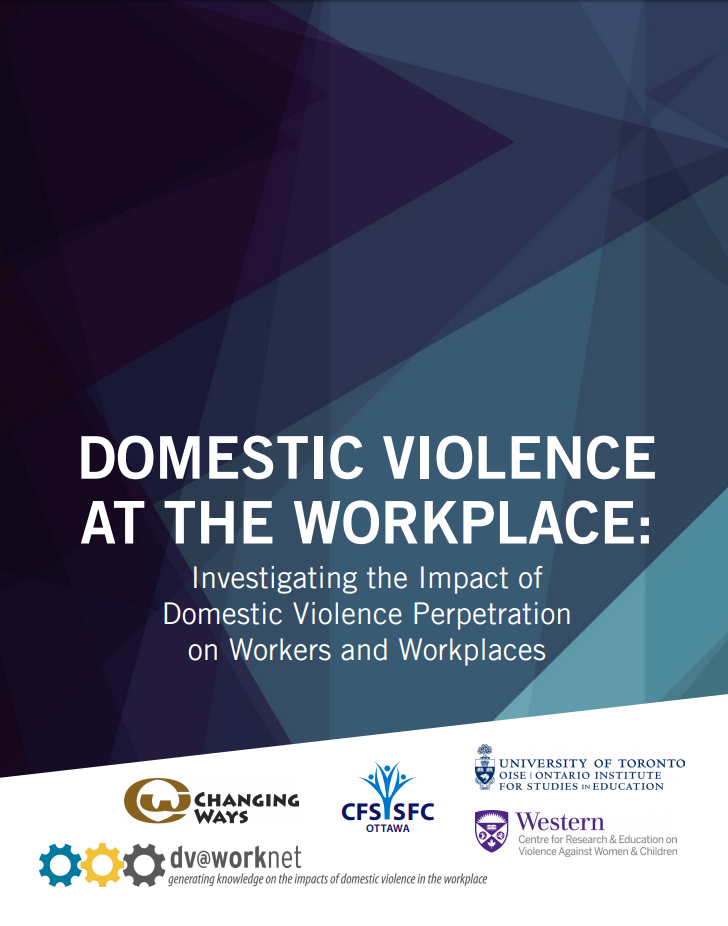Offenders in the Workplace
Ontario has a spotlight on workplace domestic violence.
- In 2010, the Occupational Health and Safety Act was amended to include domestic violence as a workplace hazard. Employers are responsible to protect workers through specific policies and procedures that include ongoing risk management once warning signs surface.
- In 2014 the first national study led by researchers at Western University and the Canadian Labour Congress revealed that from a sample of over 8000 respondents, one in three workers have experienced domestic violence and half of them have experienced it at work.
-

Almost one in ten men reported that they caused or almost caused a workplace accident as a result of being distressed or pre-occupied by the domestic violence issues.
One-third of respondents (33.9%) reported being in contact with their (ex) partner during work hours to engage in behaviours that were emotionally abusive or to monitor her actions or whereabouts. Of men who engaged in these behaviours, 25% used workplace time to drop by her home or workplace. About 20% indicated that their co-workers were aware of these behaviours.
About 25% of respondents indicated that violence issues led to difficulties getting to and staying at work and about 25% reported taking paid time off work to deal with domestic violence issues.
In October 2017, researchers from the Ontario Institute for Studies in Education (OISE) at the University of Toronto and Western University released the next step toward painting the big picture of the impacts of workplace domestic violence in a new study(Temporarily down as of February 25,2025 that looks at offenders in the workplace. Over 500 men involved with Partner Assault Response (PAR) programs contributed to the study.
The vast majority of men involved in the study are in heterosexual relationships and have been referred to intervention by the criminal justice system.
Like victimization, the high costs of offender behaviour to the workplace include compromised worker safety, lost productivity, increased risk for accidents and exposure to liability. The study found that most employers lack adequate resources to help perpetrators deal with the issue.
It’s not just employers. Society as a whole distances itself from violent men and doesn’t provide much in the way of opportunity for change. The Occupational Health and Safety Act is silent on offenders and yet the study shows clearly the risks they pose. In the Western world, our collective responses have been strictly limited to a punishment model to date. We push men who are violent further and further out of society toward social isolation, which increases their risk to re-offend.
The entire system is skewed to address violence after the fact. One child welfare agency in a rural community receives $23M per year to protect children. Domestic violence is 60% of their caseload. The entire provincial budget for Partner Assault Response (PAR) programs is $10M. PAR is the only government funded treatment program for domestic violence offenders. At this time, only men who have been charged get access. Two years ago the program time was reduced and agencies operate the program on a shoestring from year to year.

If we are ever to get ahead of the curve, we have to be willing to invest in stopping the violence before it happens. This requires a willingness to see the potential for change and to lean into it. Research shows that most men can change their behaviour if they have support. We could learn a lot from Indigenous communities who believe that men who are violent need support to return to their communities as contributing members. Leaders have created the “I am a kind man” program to engage violent men in that process of returning..
"We know that domestic violence is a prevalent social problem, so it only follows that those who perpetrate this violence are our co-workers, our supervisors, and those working under our supervision," said Tim Kelly, Executive Director of Changing Ways, the Partner Assault Response Program in London. "This means our prevention and our intervention plans must address those who perpetrate domestic violence as well as victims."
Increasingly, there is recognition that working as early as possible with offenders to change aggressive and violent behaviour is the upstream solution. In this way, we are at the beginning of a broad based social transition in which employers can choose to play a significant role by creating the conditions and the expectation that workers can and will stop violent behaviour if they are supported at the same time as they are held accountable for their actions. Progressive discipline rather than zero tolerance is the way forward.The change is the recognition that violent men are fathers, brothers, cousins, friends, and yes co-workers. They are part of the human circle.






